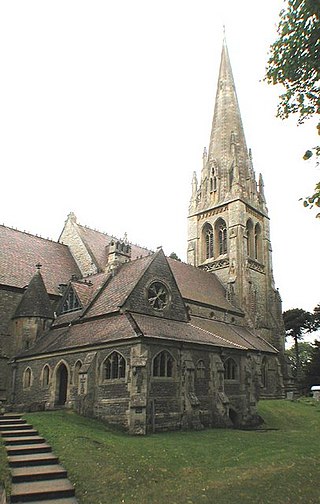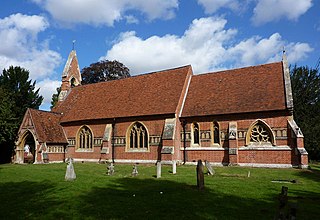
Loughton is a town and civil parish in the Epping Forest District of Essex. Part of the metropolitan and urban area of London, the town borders Chingford, Waltham Abbey, Theydon Bois, Chigwell and Buckhurst Hill, and is 12 miles (19 km) northeast of Charing Cross.

Chigwell is a town and civil parish in the Epping Forest District of Essex, England. It is part of the urban and metropolitan area of London, and is adjacent to the northern boundary of Greater London. It is on the Central line of the London Underground.

Childerditch is a settlement and former civil parish now in the unparished area of Brentwood, in the Brentwood district, in the county of Essex, England. It forms part of the Warley borough council ward. In 1931 the parish had a population of 184. On 1 April 1934 the parish was abolished and merged with Brentwood, part also went to Little Burstead.

Little Hallingbury is a small village and a civil parish in the Uttlesford district of Essex, England.

The Royal Corinthian Yacht Club is a watersports organisation based at Burnham-on-Crouch, Essex.
West Hatch High School is a secondary school located in Chigwell, Epping Forest, Essex. The area now occupied by West Hatch was previously the western gate into Epping Forest; it is from these roots that the school derives its name. The school currently educates 1,300 students from the local catchment area, and nearly 200 sixth form pupils from north east London and west Essex.

Henry Woodyer (1816–1896) was an English architect, a pupil of William Butterfield and a disciple of A. W. N. Pugin and the Ecclesiologists.
Baythorne End is a hamlet in the English county of Essex, England. It is located directly on the border with Suffolk. The hamlet is within the civil parish of Birdbrook and forms a part of the Braintree parliamentary seat. Immediate neighbouring villages include: Ridgewell, Sturmer, Stoke-by-Clare and Wixoe.
Alfred Savill (1829–1905) was the founder of Savills, one of the United Kingdom's largest estate agents.
Joseph Clarke (1819–1888) was a British Gothic Revival architect who practised in London, England.

Twinstead is a village and a civil parish in the Braintree District, in the English county of Essex. It was once part of the Hinckford Hundred, which is a subdivision of a county and has its own court. In the 1870s, Twinstead was described as:

The Church of St Mary the Virgin is the parish church of South Benfleet, Essex. The church dates to around the 12th century, and predates the neighbouring Hadleigh Castle, which lies to the east a few miles away. The church was designated as a Grade I listed building in 1952.
Comarques is an 18th-century country house in Thorpe-le-Soken, Essex, England. It has been attributed to the architect, Sir Robert Taylor. Named after Captain Comarque, a Huguenot refugee who owned the estate in the early 18th century, the house is in the Queen Anne style. The author Arnold Bennett lived at Comarques between 1913 and 1921. There is a tradition that Clement Attlee lived at the house as a child, but Historic England does not support this claim. Comarques is a Grade II* listed building.

Hemingstone Hall is a Jacobean manor house in Hemingstone close to Ipswich in Suffolk, England. It was built in the early 17th Century, around 1625, for William Style. The house is of two storeys, with attics, and is built to an H-plan in red brick. James Bettley, in his 2015 revised volume, Suffolk: East, of the Pevsner Buildings of England series, records the two-storey porch with Tuscan pilasters and obelisks.

Kelvedon Hall is a country house in the village of Kelvedon Hatch, near Brentwood, Essex, England. Originally the site of an important medieval manor, the current house was built in the mid-18th century by a family of Catholic landowners, the Wrights, who had bought the manor in 1538. The last of the Wrights to live at the house died in 1838 and it was then let, before being sold to a school. In 1937 the hall was bought by Henry “Chips” Channon, a wealthy Anglophile socialite. Kelvedon appears repeatedly in Channon's diaries, an intimate record of his social and political life from the 1920s to the 1950s. The hall remains the private home of the Channon family. It is a Grade I listed building.

Bradwell Lodge is a country house in the village of Bradwell-on-Sea, on the Dengie Peninsula in Essex, England. Originally a Tudor rectory, in the 18th century the house was purchased by the Reverend Sir Henry Bate Dudley. Bate Dudley engaged John Johnson, Surveyor of the County of Essex, to build a large Neoclassical extension. In the 20th century, the lodge was the home of Tom Driberg. Bradwell remains a private residence. It is a Grade II* listed building.
Henry Stock (1824/5–1909) was a British architect. He served as the county surveyor for Essex for nearly 50 years, and as the surveyor and architect to the Worshipful Company of Haberdashers. The latter appointment led Stock to undertake a considerable number of educational commissions, but his primary field of activity was in the construction of manufacturing sites and warehouses in London.

St Mary's Church is an active parish church in the village of Great Baddow, Essex, England. The church stands on the High Street in the centre of the village and dates from the 12th century. Much extended in the 16th century, and heavily restored in the 19th and 20th centuries, the church is a Grade I listed building.












